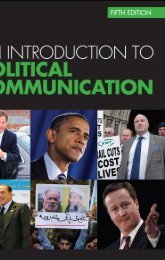Understanding global security - Peter Hough
Understanding global security - Peter Hough
Understanding global security - Peter Hough
Create successful ePaper yourself
Turn your PDF publications into a flip-book with our unique Google optimized e-Paper software.
HEALTH THREATS TO SECURITY<br />
of minimizing human suffering. Despite some reservations and concerns, Save the<br />
Children still concluded in their study that ‘GAVI was generally seen as a positive<br />
development in all four countries (LSHTM 2002: 44). Similarly, Brugha and Walt<br />
writing in the British Medical Journal accepted that: ‘It is only through a <strong>global</strong> fund<br />
that this kind of concerted <strong>global</strong> action between major corporate and public sector<br />
players can be achieved’ (Brugha and Walt 2001: 154). That business is driven by<br />
profit and that market forces are not always compatible with the public good is<br />
obvious and something to be safeguarded against in politics but, if the public good<br />
can be served by uniting actors with disparate reasons for achieving a similar goal,<br />
then socially conscious politicians should not instinctively dismiss such alliances.<br />
Other UN agencies contributing to <strong>global</strong> health<br />
UNAIDS was set up as a programme of the WHO in 1986 in response to the spread<br />
of the new disease along similar lines to its other disease fighting arms. In 1996, however,<br />
UNAIDS became a UN programme in its own right co-sponsored by the<br />
WHO, the World Bank, UNESCO, United Nations Population Fund (UNFPA),<br />
UNDP, United Nations Children Fund (UNICEF) and (later) United Nations Office<br />
on Drugs and Crime (UNDCP). This reflected the scale of the threat posed by AIDS,<br />
necessitating a response beyond the means of the WHO, but also, according to some,<br />
a lack of faith in the WHO to lead such a venture (Godlee 1994: 1494–1495). UNAIDS<br />
is based in Geneva with a Secretariat of 129, divided between the headquarters<br />
and various country offices. It is the first UN organ to include pressure group representatives<br />
in its executive, although voting rights in the Programme Coordinating<br />
Board are restricted to the 22 government representatives, elected by ECOSOC<br />
according to geographical quotas. The seven co-sponsors also have permanent<br />
representation on the board without voting rights and many of their field workers<br />
carry out UNAIDS work in developing countries. UNAIDS has a modest annual<br />
budget of $60 million but its role is that of a ‘catalyst and coordinator on AIDS rather<br />
than as a direct funding or implementing agency’ (UNAIDS 2002: 2).<br />
UNAIDS<br />
The World Bank from the outset was intended to play a role in promoting public<br />
health in LDCs through its Health, Nutrition and Population division (HNP), although<br />
it was not until 1970 that it granted a loan via this arm of its organization (Abbasi<br />
1999). By the 1990s, however, the HNP was outstripping the WHO in its outlay on<br />
projects (Stott 1999). The 1993 World Development Report ‘Investing in Health’<br />
heralded this new direction for the World Bank, inspired by a desire to be more<br />
compassionate in its development projects and the pragmatic logic that economic<br />
growth is more likely in a healthy population.<br />
World Bank<br />
169
















